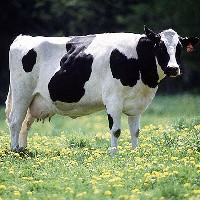A farmer’s report about an unusual forage grass for dairy cattle led a geneticist at the USDA’s Agricultural Research Service (ARS) to rediscover a forgotten type of grass with advantages for today’s farms. The grass, known as meadow fescue (Schedonorus pratensis), has been found in parts of Wisconsin, Iowa, and Minnesota.
Charles Opitz found the grass growing in deep shade on his dairy farm near Mineral Point, Wisconsin. He reported that his cows not only liked the grass, they also produced more milk when they ate it.
Michael Casler, a geneticist at the U.S. Dairy Forage Research Center in Madison, Wisconsin, used DNA to identify Opitz’s find as meadow fescue. This type of grass was once popular with farmers, but has since been eclipsed by more modern varieties.
Nontoxic fungi called endophytes live inside meadow fescue, helping it survive heat, drought, and pests. Unlike the toxic endophytes that inhabit many commercial varieties of tall fescue and ryegrass, meadow fescue’s endophytes do not poison. ARS says meadow fescue is also highly adaptable, very winter hardy, and persistent, having survived decades of farming.
Geoffrey Brink, an ARS agronomist working with Casler, examined the digestibility of the fiber in meadow fescue’s cell walls. Brink says they discovered that fiber of meadow fescue is 4 to 7 percent more digestible than other cool-season grasses dominant in the United States.
Other studies have shown meadow fescue had a nutritional forage quality advantage over more modern varieties, but with slightly lower annual yields. ARS has developed a new variety of meadow fescue, and its seed is being grown for future release.
* * *


 RSS - Posts
RSS - Posts
You must be logged in to post a comment.